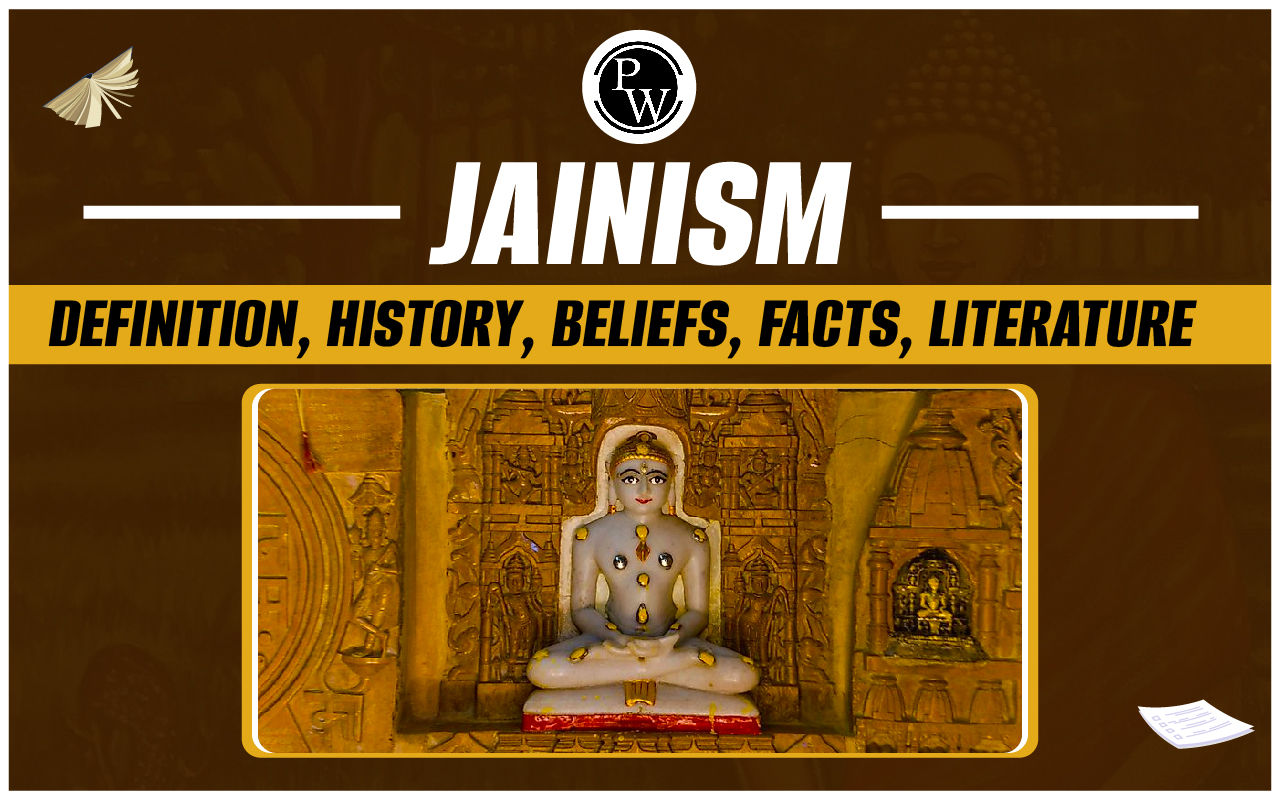

Jainism: Jainism, alongside Hinduism and Buddhism, stands as one of the oldest religious traditions in India, shaping South Asian spirituality for centuries. Despite sharing some ideas with Hinduism and Buddhism due to cultural ties, Jainism is distinct and should be seen as an independent faith, not a branch of Hinduism or Buddhism, as once thought.
The term "Jainism" comes from the Sanskrit word "ji," meaning "to conquer." It signifies the inner struggle Jain monks and nuns undertake to conquer their desires and senses for spiritual enlightenment. Those who achieve enlightenment are called Jinas, or "Conquerors," and followers of the faith are known as Jains or Jainas. Although Jainism has primarily been practiced in India, the migration of Indians to English-speaking countries has spread its influence, particularly in Commonwealth nations and the United States. While exact figures are unavailable, it's estimated that there are over six million Jains globally, with the majority residing in India.History of Jainism
Jainism, a religion with roots dating back to the 7th to 5th century BCE, emerged in the vibrant religious landscape of ancient India, particularly in the Ganges basin region. During this time, various spiritual movements arose, challenging the dominance of ritualistic Brahmanic traditions and advocating for asceticism and spiritual enlightenment as paths to liberation from the cycle of rebirth. The Jain tradition traces its origins to Parshvanatha, a revered figure who lived around the 7th century BCE. He is considered the 23rd Tirthankara, or spiritual leader, in Jainism. Later, Mahavira, often referred to as the 24th Tirthankara, further shaped Jain philosophy and practice. Like the Buddha, Mahavira renounced his princely status at the age of 30 to pursue a life of intense asceticism. He eventually gained a following, and his teachings laid the foundation for the Jain monastic community. After Mahavira's death, the Jain community experienced rapid growth, with thousands of monks and nuns following his teachings. However, doctrinal differences led to schisms within the community, most notably the division between the Shvetambara and Digambara sects. The primary point of contention between these sects was the attire of monks, with the Shvetambaras advocating for white robes and the Digambaras practicing nudity among monks. Despite internal divisions, Jainism continued to spread across India, particularly during the Gupta dynasty. The religion found patronage among various dynasties, leading to a flourishing of Jain culture, literature, and art. In the south, Digambara Jainism thrived, enjoying support from rulers and aristocrats. However, Jainism faced challenges in the medieval period, including the rise of Muslim invasions and the emergence of Hindu devotional movements. Despite these challenges, Jain communities persisted, adapting to changing political landscapes and societal norms. Various reform movements within Jainism aimed to revitalize the faith and address internal issues. In modern times, Jainism has expanded beyond India, with diaspora communities in countries like the United Kingdom, the United States, and Canada. These communities have played a vital role in preserving Jain traditions and values while also contributing to wider society through charitable work and advocacy. Today, Jainism continues to be a vibrant religious tradition, emphasizing principles such as nonviolence, vegetarianism, and environmentalism. With the advent of online resources and trans-sectarian organizations, Jain teachings are reaching a global audience, ensuring the preservation and dissemination of this ancient faith for future generations.Key Figures in Jain Legend
The Jain tradition holds a rich legendary history known as the Deeds of the 63 Illustrious Men, which includes significant figures like the 24 Tirthankaras. These Tirthankaras are revered as enlightened beings who periodically appear to teach and embody the Jain faith. Alongside these spiritual figures, Jain legend also incorporates key figures from Hindu tradition, such as Krishna and Rama. Krishna, for instance, is considered a cousin of the 22nd Tirthankara, Arishtanemi, in Jain lore. Similarly, Rama, the hero of the Hindu epic Ramayana, is depicted as a devout and nonviolent follower of Jain principles. By integrating these Hindu figures into their own legendary narratives, Jains both maintain connections with Hindu culture and establish their distinct identity. This blending of traditions allows Jains to navigate their relationship with the broader Hindu community while upholding their unique beliefs and practices. Through their legends, Jains emphasize the importance of spiritual enlightenment and adherence to nonviolence, values that resonate across both Jain and Hindu traditions.Beliefs of Jainism
Jainism, an ancient Indian religion, centers around the idea of achieving spiritual purity and liberation of the soul. Central to Jain beliefs is the concept of non-violence, where followers strive to avoid harming any living being. Jainism teaches that all souls are equal and possess the potential for enlightenment. The religion emphasizes self-discipline, ethical conduct, and non-attachment to material possessions. Through practices like meditation, fasting, and adherence to strict moral principles, Jains seek to attain liberation from the cycle of birth and death, aiming for eternal peace and enlightenment.The Goal of Jainism
The ultimate aim of Jainism is the complete purification and liberation of the soul. This state of liberation, called moksha, is achieved when the soul is freed from the cycle of birth and death, known as samsara.The Problem of Karma
Jainism teaches that the soul is bound by karma, which are tiny particles that accumulate as a result of a person's actions. These karmic particles attach themselves to the soul and bind it to the cycle of reincarnation. The accumulation of karma obstructs the soul's ability to realize its true nature and attain liberation.Jain Cosmology
According to Jain belief, time is eternal and cyclical, consisting of ascending and descending phases. The universe is eternal and composed of five fundamental elements: soul, matter, space, motion, and rest. Jains divide the inhabited universe into various realms, including hells, the human world, celestial realms, and realms inhabited by liberated souls.Jiva and Ajiva
Jain reality is divided into two categories: jiva, which refers to living beings or souls, and ajiva, which encompasses non-living substances. Jiva possesses consciousness, bliss, and energy, while ajiva lacks consciousness and includes material substances, space, time, and principles of motion.The Nature of Karma
Karma is the cause of bondage and liberation in Jainism. It is acquired through intentional actions and must be eradicated to achieve liberation. Jain teachings emphasize the importance of non-violent actions and self-discipline to minimize the influx of new karma and eliminate existing karma.The Path to Liberation
Jain doctrine prescribes a path of spiritual practice, known as yoga, to attain liberation. This path involves cultivating right knowledge, faith, and conduct. Right knowledge involves understanding the true nature of reality, while right faith leads to detachment and tranquility. Right conduct is based on non-violence and ethical living.Ethical Principles
Non-violence (ahimsa) is the cornerstone of Jain ethics. Jains strive to avoid causing harm to any living being, whether through physical, mental, or verbal actions. Jainism teaches that non-violence is the highest form of religious practice and emphasizes vegetarianism as a means of minimizing harm to living beings.Religious Beliefs and Traditions
Jain religious beliefs and traditions encompass a disciplined way of life practiced by both monks and lay followers. Monks and nuns adhere to strict vows, while laypeople observe moral conduct and engage in rituals like worship and pilgrimage. Image veneration and festivals play significant roles, reflecting Jainism's rich spiritual heritage and communal practices.Monks, Nuns, and Their Practices
Jain monks and nuns, known for their ascetic lifestyle, follow strict rules and practices. Shvetambara monks are allowed to retain a few possessions such as robes, an alms bowl, and a whisk broom. They must adhere to "great vows" to avoid harming any life-form, lying, stealing, engaging in sexual activity, or accepting personal possessions. Digambara monks, on the other hand, remain naked or wear minimal clothing, adhering to a more intense interpretation of non-possession. All Jain renunciants must exercise care in thought, speech, and action, along with vigilance over conduct. They perform daily obligatory actions, including equanimity, praise of Tirthankaras, confession, and resolution to avoid sinful activities. The pinnacle of asceticism for monks is sallekhana, a ritual starvation that symbolizes self-control and triumph over passions. Nuns also follow similar vows and practices but are often considered less prestigious than monks. However, they play a crucial role in the Jain community, despite facing societal conventions that require them to defer to monks.Religious Activity of the Laity
While Jainism emphasizes the importance of monks, the majority of followers are laypersons who support the monastic community. Laypeople observe eight basic rules of behavior, including avoiding violence and limiting possessions. They also undertake various vows, such as abstaining from falsehood and stealing. Regular rituals, including meditative activities like samayika, help lay Jains strengthen their spiritual discipline. Life in Jainism revolves around strict vegetarianism, disciplined professional activity, and responsible family conduct.Image Veneration
Jainism incorporates temple worship and image veneration, although Tirthankaras are considered beyond offerings and worship. Devotional acts serve as meditative disciplines, with daily worship involving hymns, prayers, idol veneration, and offerings. Temples house images of Tirthankaras, and lay worshippers offer prayers and perform rituals to seek aid in worldly matters.Festivals
Jain festivals, known as parvan, coincide with significant events in the lives of Tirthankaras. Paryushana, the most significant festival for Shvetambaras, involves fasting, preaching, and scriptural recitation. Digambaras celebrate Dashalakshanaparvan, focusing on the display of important texts. Other festivals include Mahavira Jayanti, commemorating the birth of Mahavira, and Mastakabhisheka, a grand ceremony performed every 12 years at Shravanabelagola.Pilgrimage
Pilgrimage holds special significance in Jainism, viewed as a meritorious activity. Pilgrimage sites mark events in the lives of Tirthankaras, attracting both renunciants and lay followers. Important pilgrimage destinations include Parasnath Hill, Shatrunjaya, Girnar Hills, and Shravanabelagola.Jain literature
Jain literature, spanning various subjects like philosophy, poetry, and science, holds a rich cultural heritage within Jainism. It encompasses sacred texts, commentaries, and philosophical works, reflecting the tradition's deep philosophical roots and diverse literary contributions across languages like Tamil, Kannada, Prakrit, and Sanskrit.Canonical and Commentarial Literature
Jainism's sacred texts aren't from one era, and many have undergone revisions. They were first organized in meetings like the one at Patna around the 4th century BCE. Later councils at Mathura and Valabhi further refined these scriptures. The original teachings, called Purvas, are lost, and the existing scriptures are divided among the Shvetambara and Digambara sects. Shvetambaras follow an extensive collection of texts called Agamas, while Digambaras recognize the Karmaprabhrita and Kashayaprabhrita as their canon.Shvetambara Literature
Shvetambara texts include 45 scriptures divided into categories like Angas, Upangas, and others. The Acharanga and Sutrakritanga are among the oldest. Bhadrabahu is credited with the Niryuktis, early commentaries on Jain texts. These evolved into Bhashyas and Churnis, which led to Sanskrit commentaries by authors like Haribhadra and Shilanka.Digambara Literature
Digambaras consider the Karmaprabhrita and Kashayaprabhrita as their primary texts. Kundakunda's works, like Pravachanasara and Samayasara, are highly regarded. His writings often use a two-perspective model, emphasizing inner spiritual interpretation.Philosophical and Other Literature
Jain literature covers a wide range of subjects like philosophy, poetry, and science. The Tattvartha-sutra by Umasvati is a fundamental Jain philosophical work. Kundakunda's writings are also significant. Jain authors made notable contributions to literature in Tamil, Kannada, Prakrit, and Sanskrit, promoting Jain ideals through narrative storytelling. Overall, Jain literature reflects the religion's rich philosophical tradition and cultural heritage.Jainism FAQs
What is Jainism?
Jainism is one of the oldest religions in India, emphasizing spiritual purity and non-violence.
What are the main beliefs of Jainism?
Jainism teaches non-violence, equality of souls, and liberation from the cycle of birth and death through self-discipline and ethical living.
Who are the key figures in Jainism?
Jainism reveres Tirthankaras, enlightened beings who guide followers towards spiritual enlightenment. Figures like Krishna and Rama also hold significance in Jain legend.
What are the practices of Jain monks and nuns?
Jain monks and nuns lead ascetic lifestyles, adhering to strict vows of non-violence and renunciation. They engage in daily rituals and practices like sallekhana, a symbolic form of fasting.
How do lay followers practice Jainism?
Lay followers observe moral conduct, engage in rituals like worship and pilgrimage, and uphold principles of non-violence and vegetarianism in their daily lives.
🔥 Trending Blogs
Talk to a counsellorHave doubts? Our support team will be happy to assist you!

Check out these Related Articles
Free Learning Resources
PW Books
Notes (Class 10-12)
PW Study Materials
Notes (Class 6-9)
Ncert Solutions
Govt Exams
Class 6th to 12th Online Courses
Govt Job Exams Courses
UPSC Coaching
Defence Exam Coaching
Gate Exam Coaching
Other Exams
Know about Physics Wallah
Physics Wallah is an Indian edtech platform that provides accessible & comprehensive learning experiences to students from Class 6th to postgraduate level. We also provide extensive NCERT solutions, sample paper, NEET, JEE Mains, BITSAT previous year papers & more such resources to students. Physics Wallah also caters to over 3.5 million registered students and over 78 lakh+ Youtube subscribers with 4.8 rating on its app.
We Stand Out because
We provide students with intensive courses with India’s qualified & experienced faculties & mentors. PW strives to make the learning experience comprehensive and accessible for students of all sections of society. We believe in empowering every single student who couldn't dream of a good career in engineering and medical field earlier.
Our Key Focus Areas
Physics Wallah's main focus is to make the learning experience as economical as possible for all students. With our affordable courses like Lakshya, Udaan and Arjuna and many others, we have been able to provide a platform for lakhs of aspirants. From providing Chemistry, Maths, Physics formula to giving e-books of eminent authors like RD Sharma, RS Aggarwal and Lakhmir Singh, PW focuses on every single student's need for preparation.
What Makes Us Different
Physics Wallah strives to develop a comprehensive pedagogical structure for students, where they get a state-of-the-art learning experience with study material and resources. Apart from catering students preparing for JEE Mains and NEET, PW also provides study material for each state board like Uttar Pradesh, Bihar, and others
Copyright © 2025 Physicswallah Limited All rights reserved.











